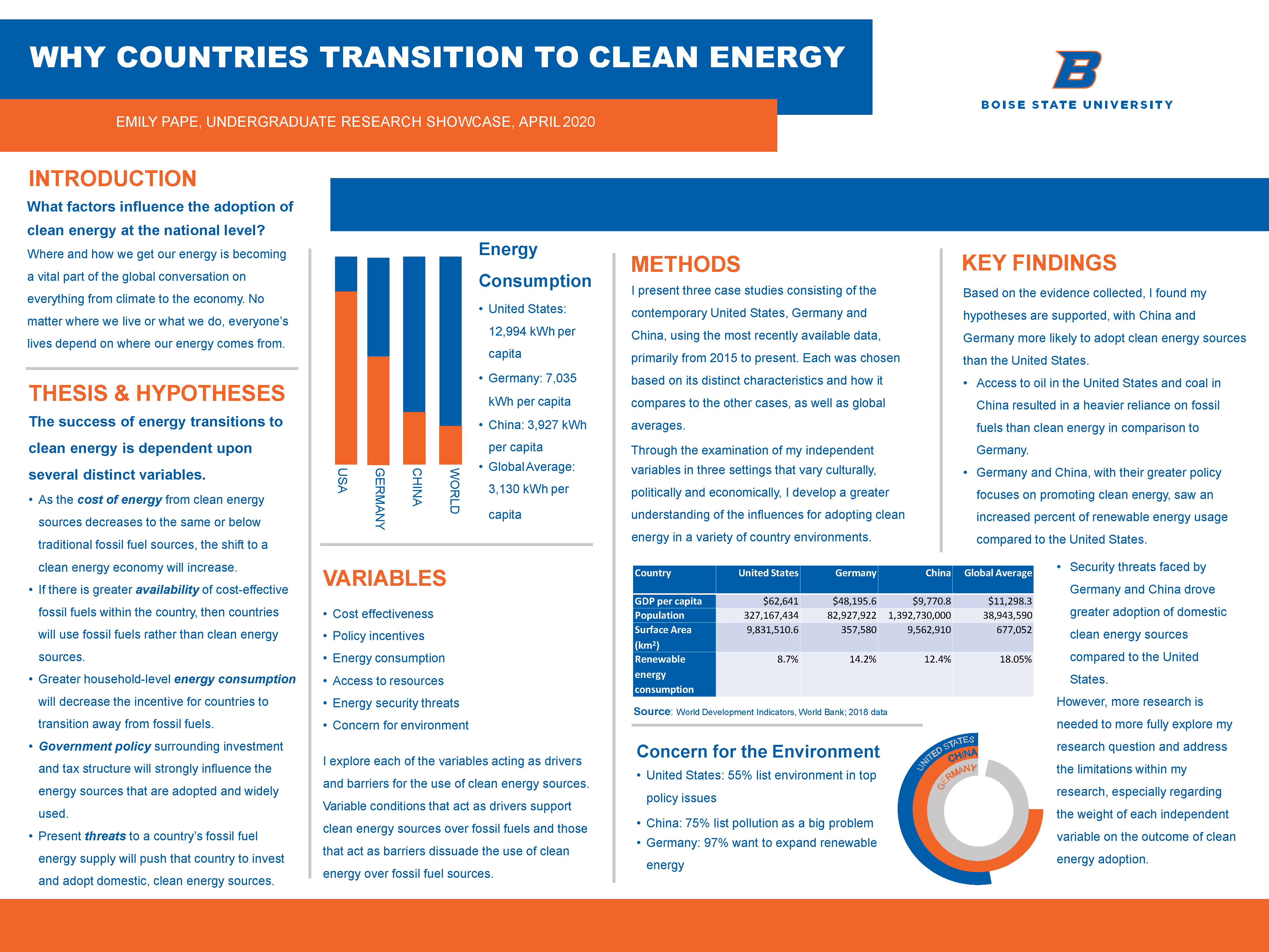Emily Pape, Dr. Brian Wampler

Introduction
What factors influence the adoption of clean energy at the national level?
Where and how we get our energy is becoming a vital part of the global conversation on everything from climate to the economy. No matter where we live or what we do, everyone’s lives depend on where our energy comes from.
Thesis and Hypotheses
The success of energy transitions to clean energy is dependent upon several distinct variables
- As the cost of energy from clean energy sources decreases to the same or below traditional fossil fuel sources, the shift to a clean energy economy will increase.
- If there is greater availability of cost-effective fossil fuels within the country, then countries will use fossil fuels rather than clean energy sources.
- Greater household-level energy consumption will decrease the incentive for countries to transition away from fossil fuels.
- Government policy surrounding investment and tax structure will strongly influence the
energy sources that are adopted and widely used. - Present threats to a country’s fossil fuel energy supply will push that country to invest and adopt domestic, clean energy sources.
Energy Consumption

- United States: 12,994 kWh per capita
- Germany: 7,035 kWh per capita
- China: 3,927 kWh per capita
- Global Average: 3,130 kWh per
capita
Variables
- Cost effectiveness
- Policy incentives
- Energy consumption
- Access to resources
- Energy security threats
- Concern for environment
I explore each of the variables acting as drivers and barriers for the use of clean energy sources. Variable conditions that act as drivers support clean energy sources over fossil fuels and those that act as barriers dissuade the use of clean energy over fossil fuel sources.
Methods
I present three case studies consisting of the contemporary United States, Germany and China, using the most recently available data, primarily from 2015 to present. Each was chosen based on its distinct characteristics and how it compares to the other cases, as well as global averages.
Through the examination of my independent variables in three settings that vary culturally, politically and economically, I develop a greater understanding of the influences for adopting clean energy in a variety of country environments.
Source: World Development Indicators, World Bank; 2018 data| Country | United States | Germany | China | Global Average |
|---|---|---|---|---|
| GDP per capita | $62,641 | $48,195.6 | $9,770.8 | $11,298.3 |
| Population | 327,167,434 | 82,927,922 | 1,392,730,000 | 38,943,590 |
| Surface Area (km2) | 9,831,510.6 | 357,580 | 9,562,910 | 677,052 |
| Renewable energy consumption | 8.7% | 14.2% | 12.4% | 18.05% |
Concern for the Environment

- United States: 55% list environment in top policy issues
- China: 75% list pollution as a big problem
- Germany: 97% want to expand renewable energy
Key Findings
Based on the evidence collected, I found my hypotheses are supported, with China and Germany more likely to adopt clean energy sources than the United States.
- Access to oil in the United States and coal in China resulted in a heavier reliance on fossil fuels than clean energy in comparison to Germany.
- Germany and China, with their greater policy focuses on promoting clean energy, saw an increased percent of renewable energy usage compared to the United States.
- Security threats faced by Germany and China drove greater adoption of domestic clean energy sources compared to the United States.
However, more research is needed to more fully explore my research question and address the limitations within my research, especially regarding the weight of each independent variable on the outcome of clean energy adoption.
Additional Information
For questions or comments about this research, contact Emily Pape at emilypape@u.boisestate.edu.